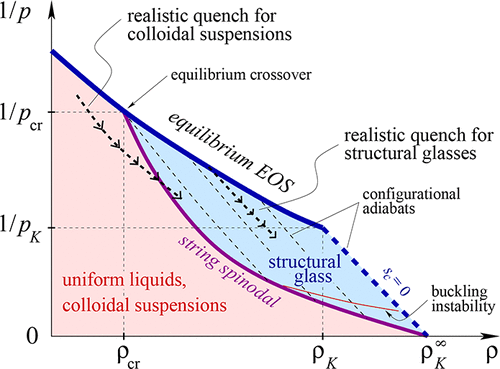当前位置:
X-MOL 学术
›
J. Phys. Chem. B
›
论文详情
Our official English website, www.x-mol.net, welcomes your
feedback! (Note: you will need to create a separate account there.)
Aging, Jamming, and the Limits of Stability of Amorphous Solids
The Journal of Physical Chemistry B ( IF 2.8 ) Pub Date : 2017-12-07 00:00:00 , DOI: 10.1021/acs.jpcb.7b09553 Vassiliy Lubchenko 1 , Peter G. Wolynes 2
The Journal of Physical Chemistry B ( IF 2.8 ) Pub Date : 2017-12-07 00:00:00 , DOI: 10.1021/acs.jpcb.7b09553 Vassiliy Lubchenko 1 , Peter G. Wolynes 2
Affiliation

|
Apart from not having crystallized, supercooled liquids can be considered as being properly equilibrated and thus can be described by a few thermodynamic control variables. In contrast, glasses and other amorphous solids can be arbitrarily far away from equilibrium and require a description of the history of the conditions under which they formed. In this paper we describe how the locality of interactions intrinsic to finite-dimensional systems affects the stability of amorphous solids far off equilibrium. Our analysis encompasses both structural glasses formed by cooling and colloidal assemblies formed by compression. A diagram outlining regions of marginal stability can be adduced which bears some resemblance to the quasi-equilibrium replica meanfield theory phase diagram of hard sphere glasses in high dimensions but is distinct from that construct in that the diagram describes not true phase transitions but kinetic transitions that depend on the preparation protocol. The diagram exhibits two distinct sectors. One sector corresponds to amorphous states with relatively open structures, the other to high density, more closely packed ones. The former transform rapidly owing to there being motions with no free energy barriers; these motions are string-like locally. In the dense region, amorphous systems age via compact activated reconfigurations. The two regimes correspond, in equilibrium, to the collisional or uniform liquid and the so-called landscape regime, respectively. These are separated by a spinodal line of dynamical crossovers. Owing to the rigidity of the surrounding matrix in the landscape, high-density part of the diagram, a sufficiently rapid pressure quench adds compressive energy which also leads to an instability toward string-like motions with near vanishing barriers. Conversely, a dilute collection of rigid particles, such as a colloidal suspension leads, when compressed, to a spatially heterogeneous structure with percolated mechanically stable regions. This jamming corresponds to the onset of activation when the spinodal line is traversed from the low density side. We argue that a stable glass made of sufficiently rigid particles can also be viewed as exhibiting sporadic and localized buckling instabilities that result in local jammed structures. The lines of instability we discuss resemble the Gardner transition of meanfield systems but, in contrast, do not result in true criticality owing to being short-circuited by activated events. The locally marginally stable modes of motion in amorphous solids correspond to secondary relaxation processes in structural glasses. Their relevance to the low temperature anomalies in glasses is also discussed.
中文翻译:

老化,干扰和非晶态固体的极限
除了没有结晶外,过冷的液体可以被认为是适当平衡的,因此可以用一些热力学控制变量来描述。相反,玻璃和其他无定形固体可以任意远离平衡,并且需要描述它们形成的条件的历史。在本文中,我们描述了有限维系统固有的相互作用的局部性如何影响远离平衡状态的非晶态固体的稳定性。我们的分析既包括通过冷却形成的结构玻璃,也包括通过压缩形成的胶体组件。可以画出边缘稳定区域的示意图,该示意图与高尺寸硬球玻璃的准平衡复制均值理论相图有些相似,但与该结构的不同之处在于该图不是描述真正的相变而是描述了动力学跃迁。取决于准备方案。该图显示了两个不同的扇区。一个区段对应于具有相对开放结构的非晶态,另一个区段对应于高密度,更紧密堆积的区段。前者由于没有自由能垒的运动而迅速转变。这些动作在局部是弦状的。在密集区域,非晶态系统会通过紧凑的激活重新配置来老化。这两种状态在平衡上对应于碰撞或均匀的液体和所谓的景观状态,分别。这些由动态交叉的旋节线分隔。由于景观中周围矩阵的刚性,图中的高密度部分,足够快速的压力淬火增加了压缩能,这也导致具有近似消失的障碍的弦状运动不稳定。相反,刚性颗粒(例如胶体悬浮液)的稀薄集合在压缩时会导致具有渗透的机械稳定区域的空间异质结构。当从低密度侧穿过旋节线时,此干扰对应于激活的开始。我们认为,由足够刚性的颗粒制成的稳定玻璃也可以被视为表现出零星的和局部的屈曲不稳定性,从而导致局部卡死的结构。我们讨论的不稳定线类似于均值系统的Gardner跃迁,但是相反,由于激活事件将其短路,因此不会导致真正的临界状态。非晶态固体中的局部边缘稳定运动模式对应于结构玻璃中的二次弛豫过程。还讨论了它们与玻璃中低温异常的相关性。
更新日期:2017-12-07
中文翻译:

老化,干扰和非晶态固体的极限
除了没有结晶外,过冷的液体可以被认为是适当平衡的,因此可以用一些热力学控制变量来描述。相反,玻璃和其他无定形固体可以任意远离平衡,并且需要描述它们形成的条件的历史。在本文中,我们描述了有限维系统固有的相互作用的局部性如何影响远离平衡状态的非晶态固体的稳定性。我们的分析既包括通过冷却形成的结构玻璃,也包括通过压缩形成的胶体组件。可以画出边缘稳定区域的示意图,该示意图与高尺寸硬球玻璃的准平衡复制均值理论相图有些相似,但与该结构的不同之处在于该图不是描述真正的相变而是描述了动力学跃迁。取决于准备方案。该图显示了两个不同的扇区。一个区段对应于具有相对开放结构的非晶态,另一个区段对应于高密度,更紧密堆积的区段。前者由于没有自由能垒的运动而迅速转变。这些动作在局部是弦状的。在密集区域,非晶态系统会通过紧凑的激活重新配置来老化。这两种状态在平衡上对应于碰撞或均匀的液体和所谓的景观状态,分别。这些由动态交叉的旋节线分隔。由于景观中周围矩阵的刚性,图中的高密度部分,足够快速的压力淬火增加了压缩能,这也导致具有近似消失的障碍的弦状运动不稳定。相反,刚性颗粒(例如胶体悬浮液)的稀薄集合在压缩时会导致具有渗透的机械稳定区域的空间异质结构。当从低密度侧穿过旋节线时,此干扰对应于激活的开始。我们认为,由足够刚性的颗粒制成的稳定玻璃也可以被视为表现出零星的和局部的屈曲不稳定性,从而导致局部卡死的结构。我们讨论的不稳定线类似于均值系统的Gardner跃迁,但是相反,由于激活事件将其短路,因此不会导致真正的临界状态。非晶态固体中的局部边缘稳定运动模式对应于结构玻璃中的二次弛豫过程。还讨论了它们与玻璃中低温异常的相关性。











































 京公网安备 11010802027423号
京公网安备 11010802027423号